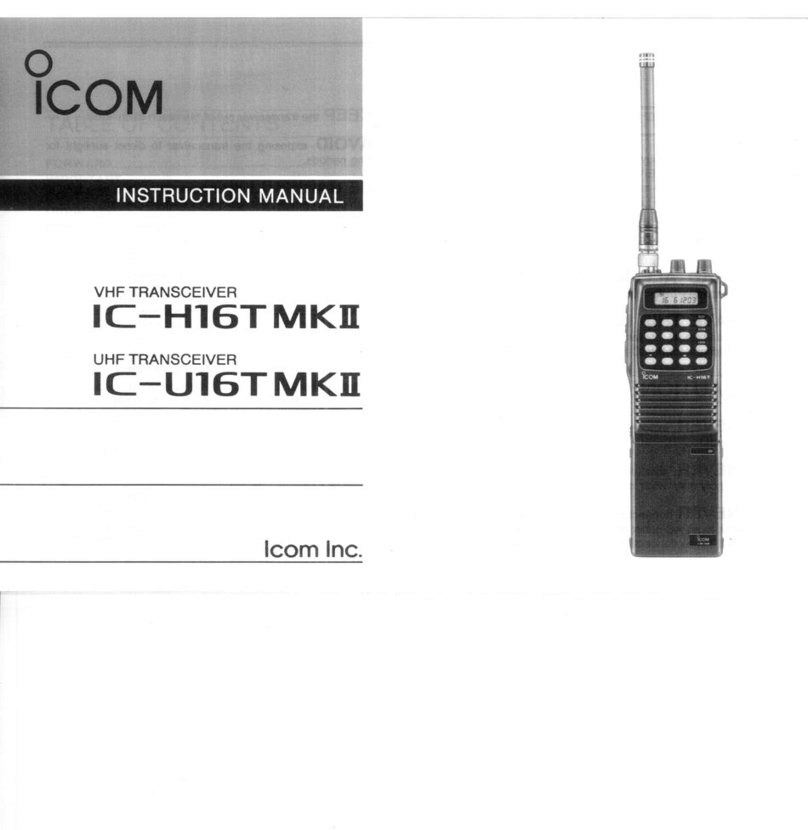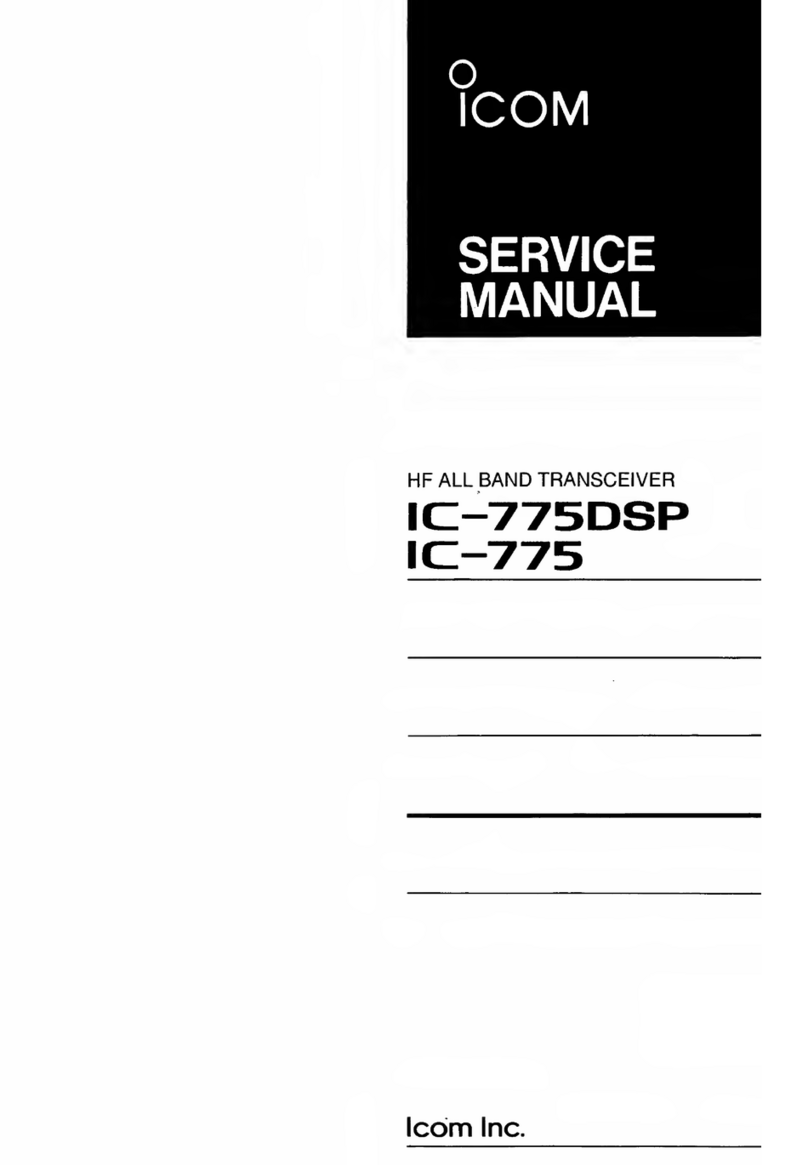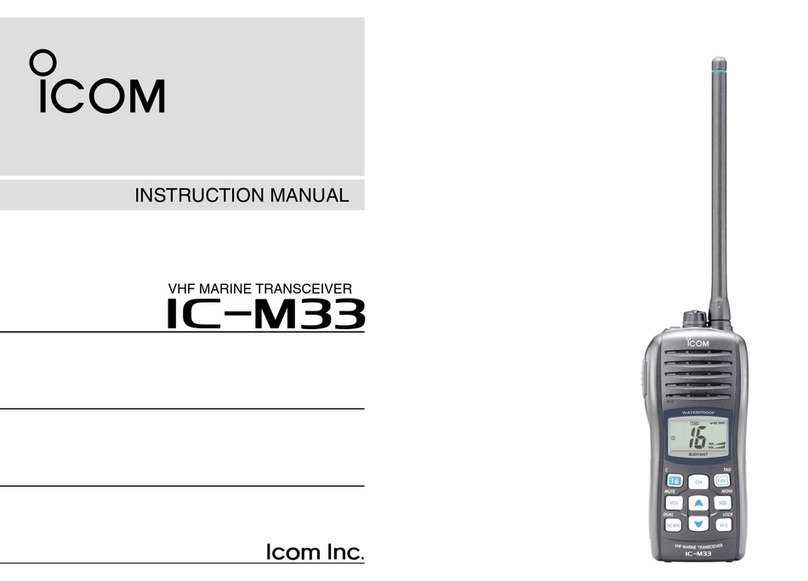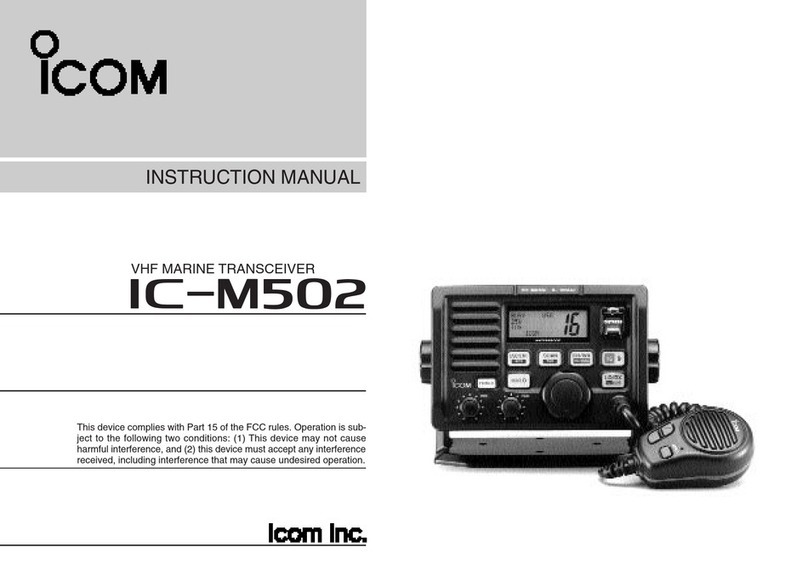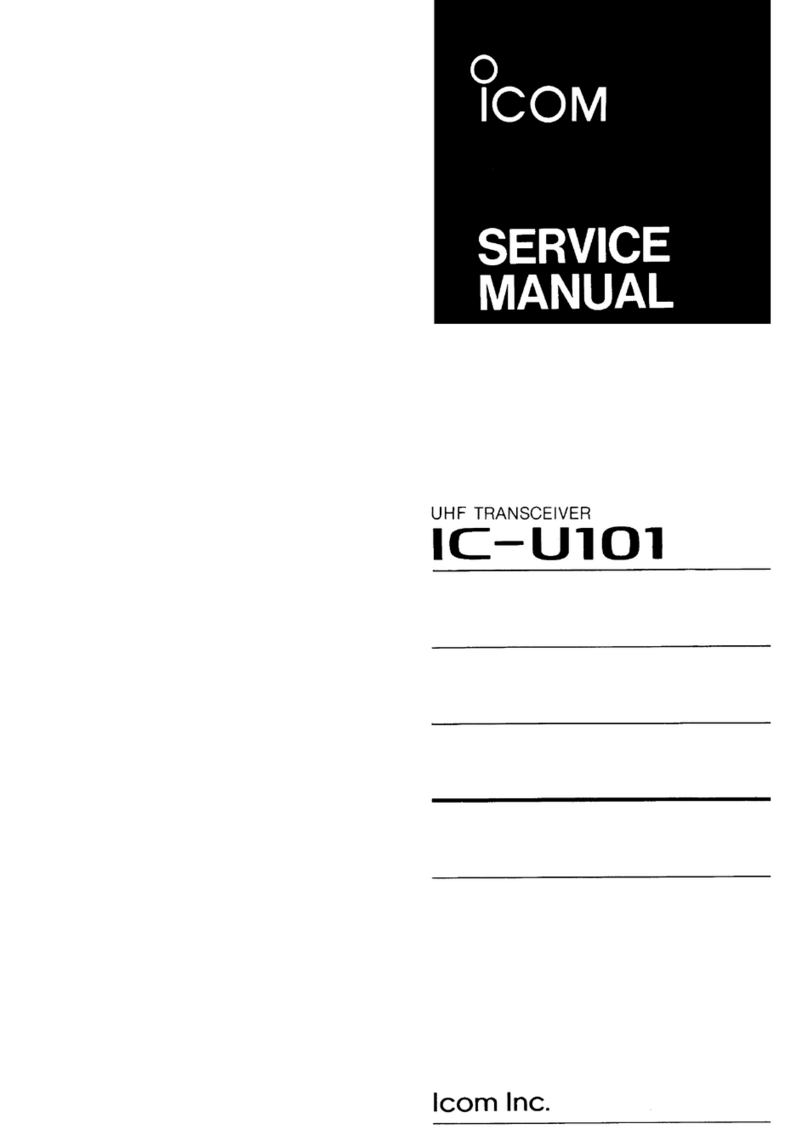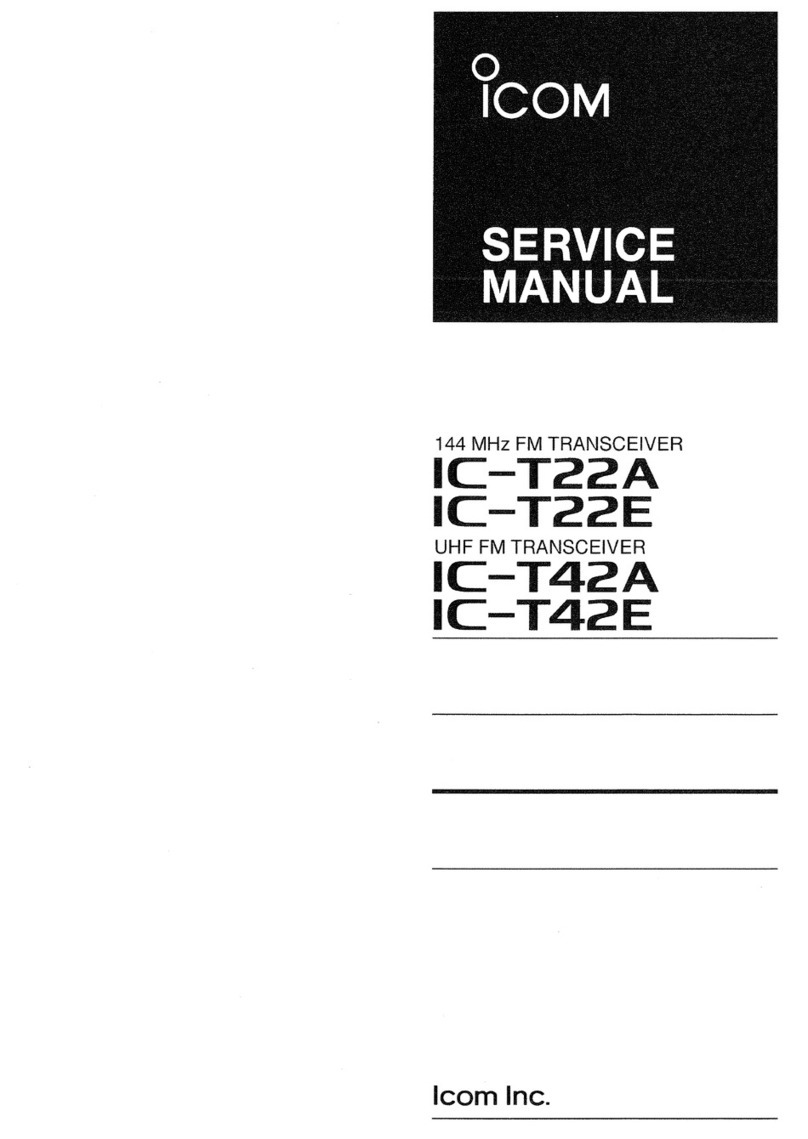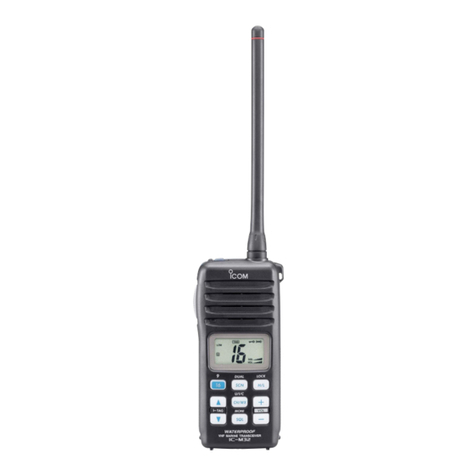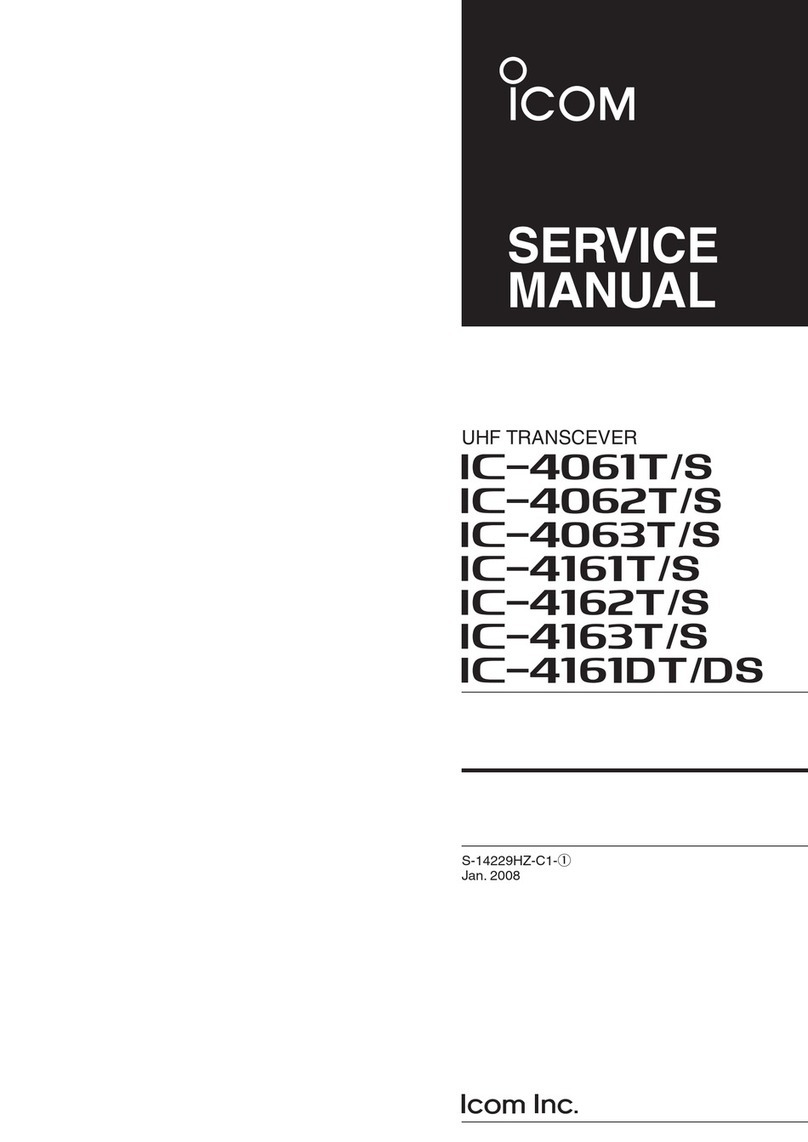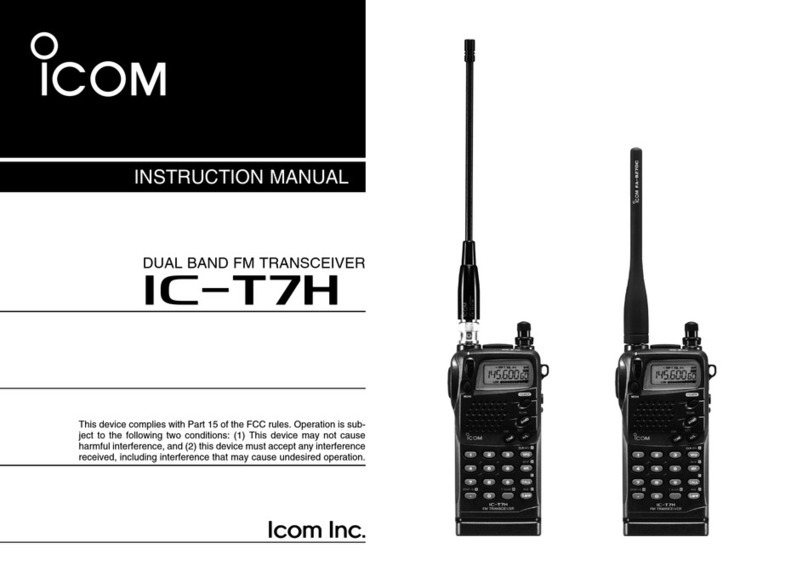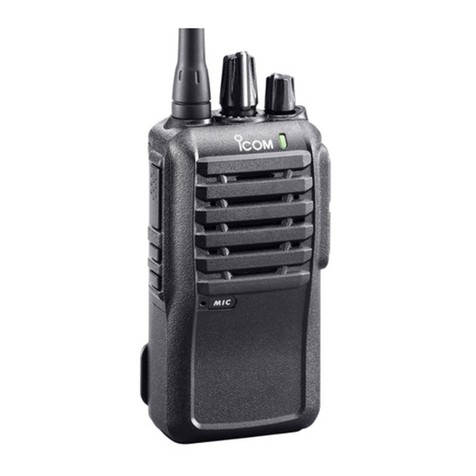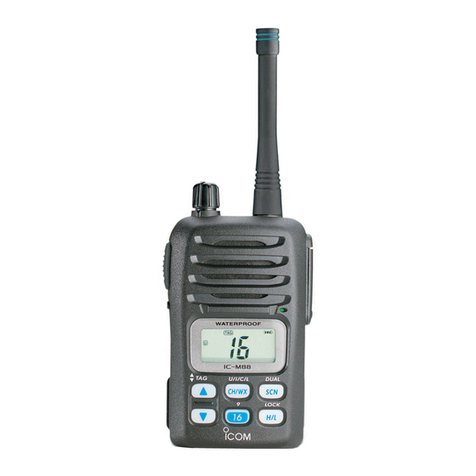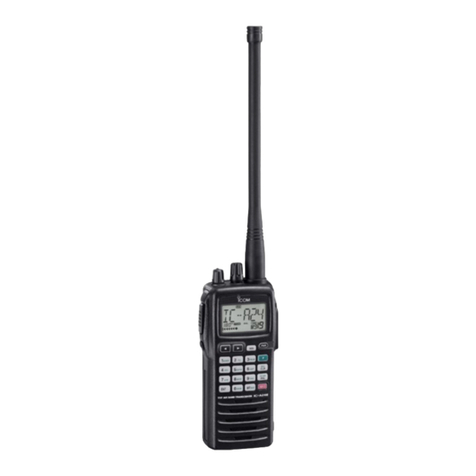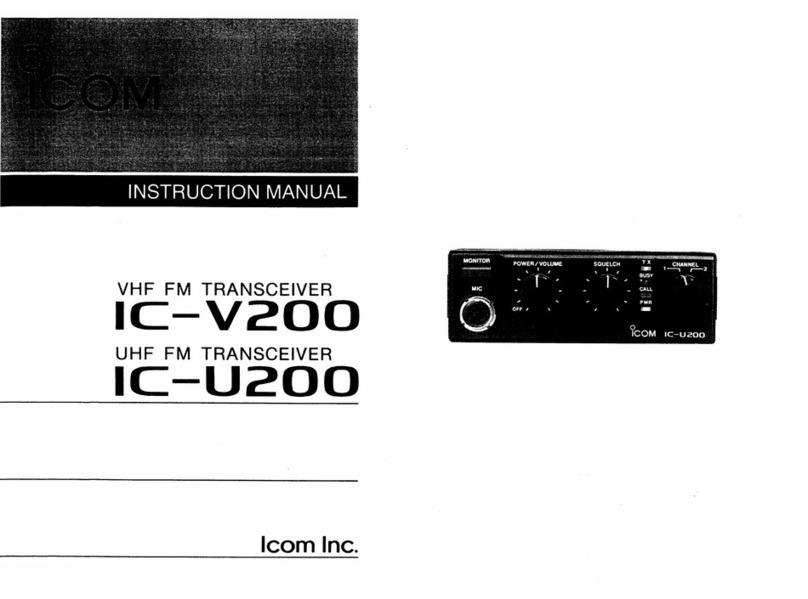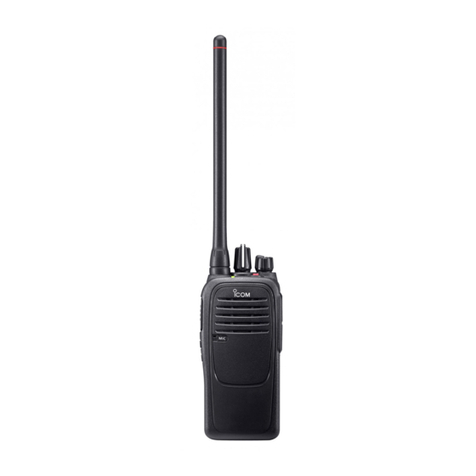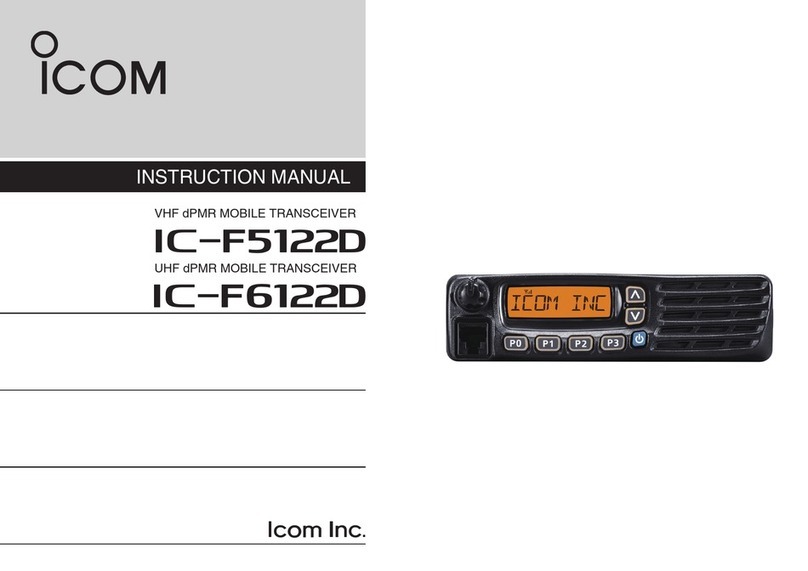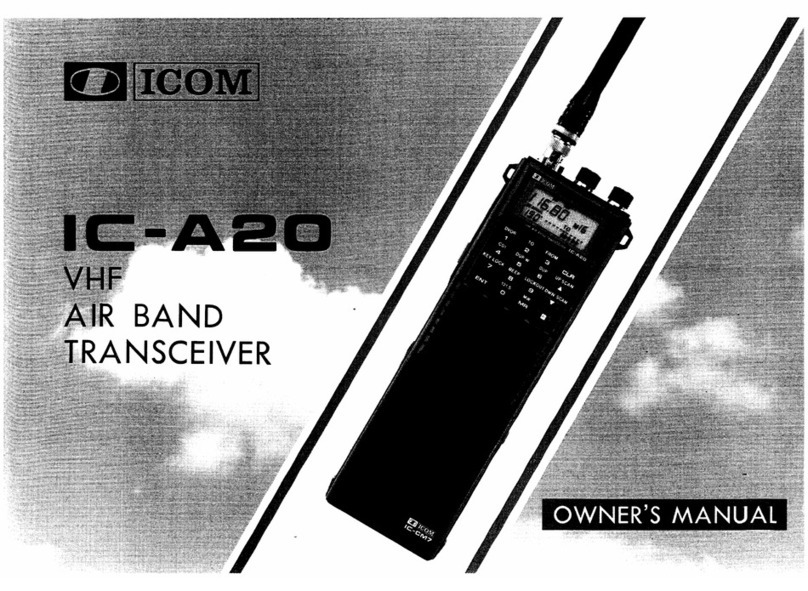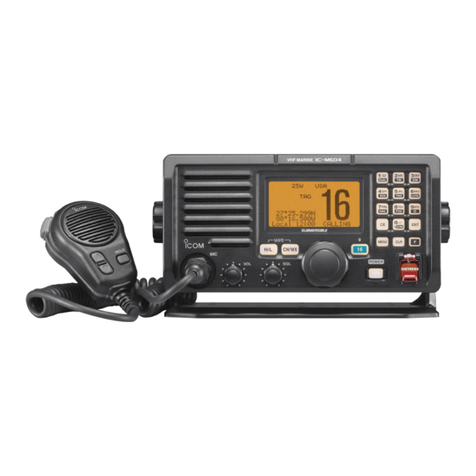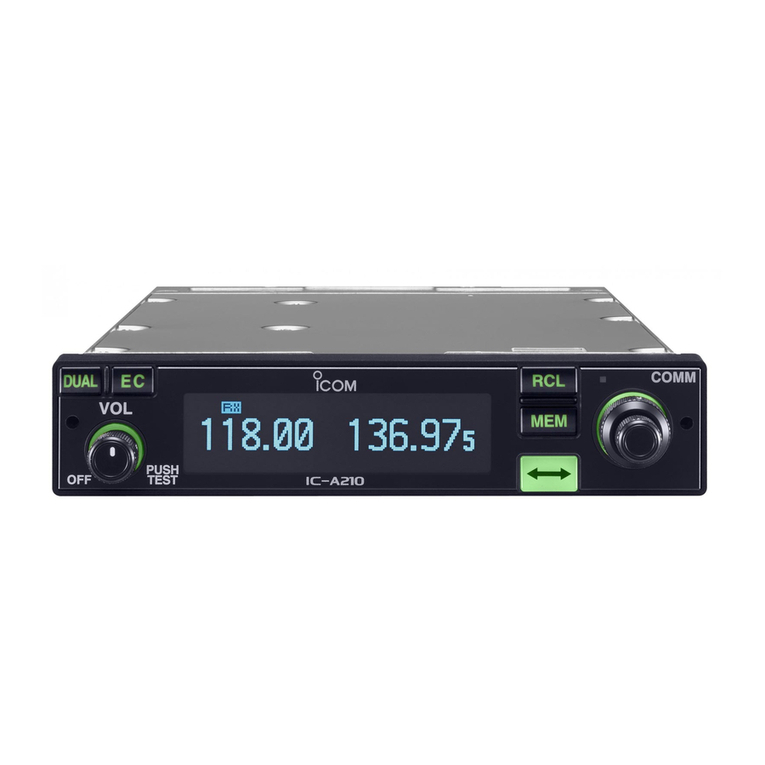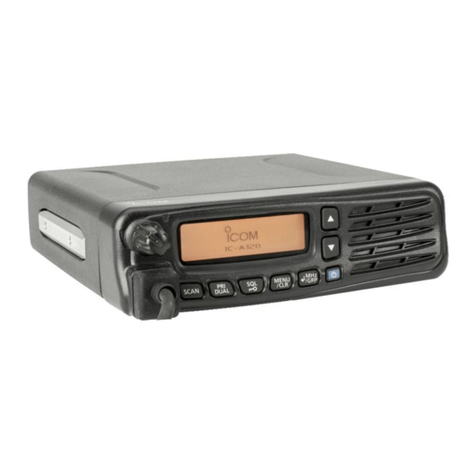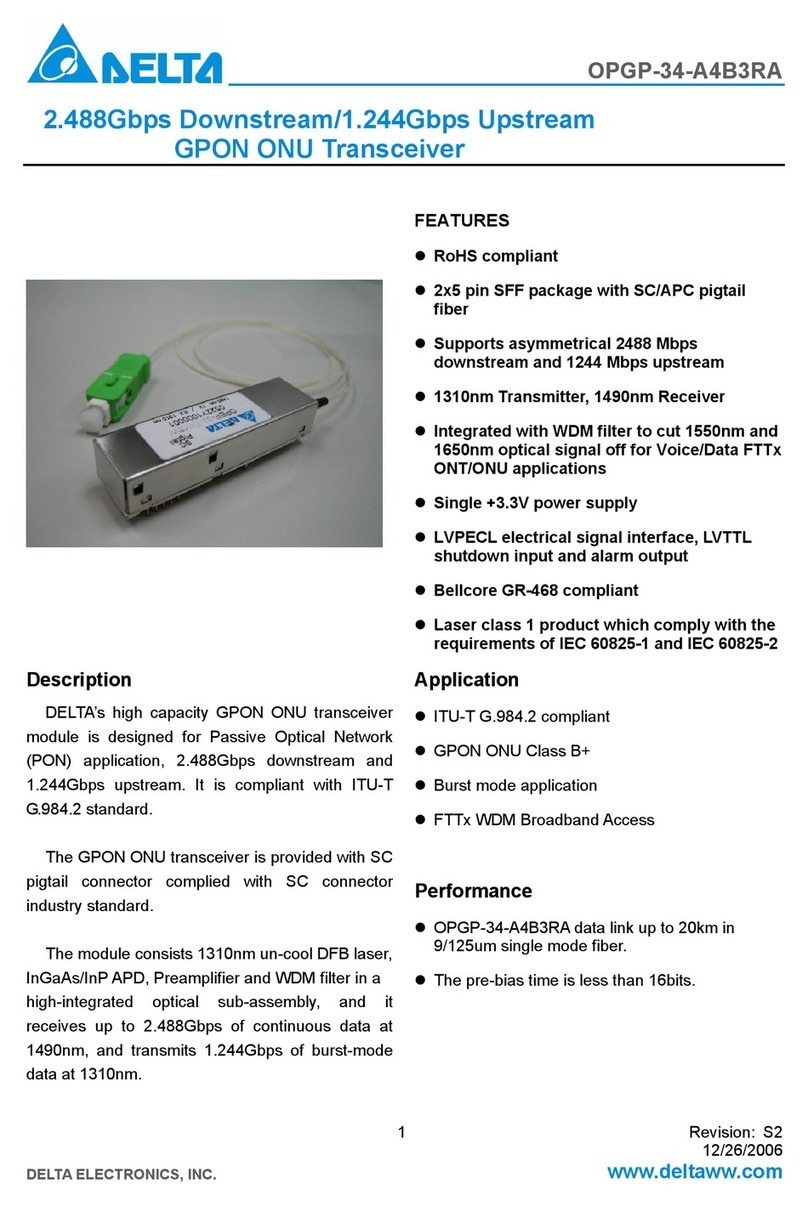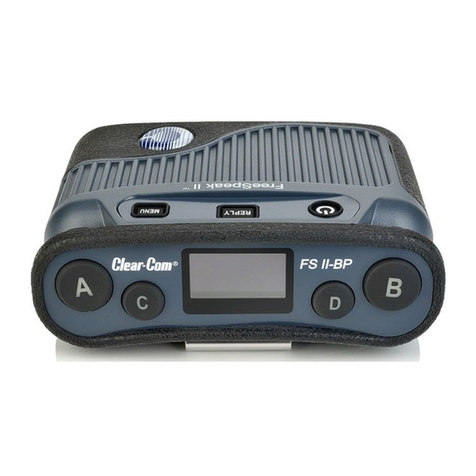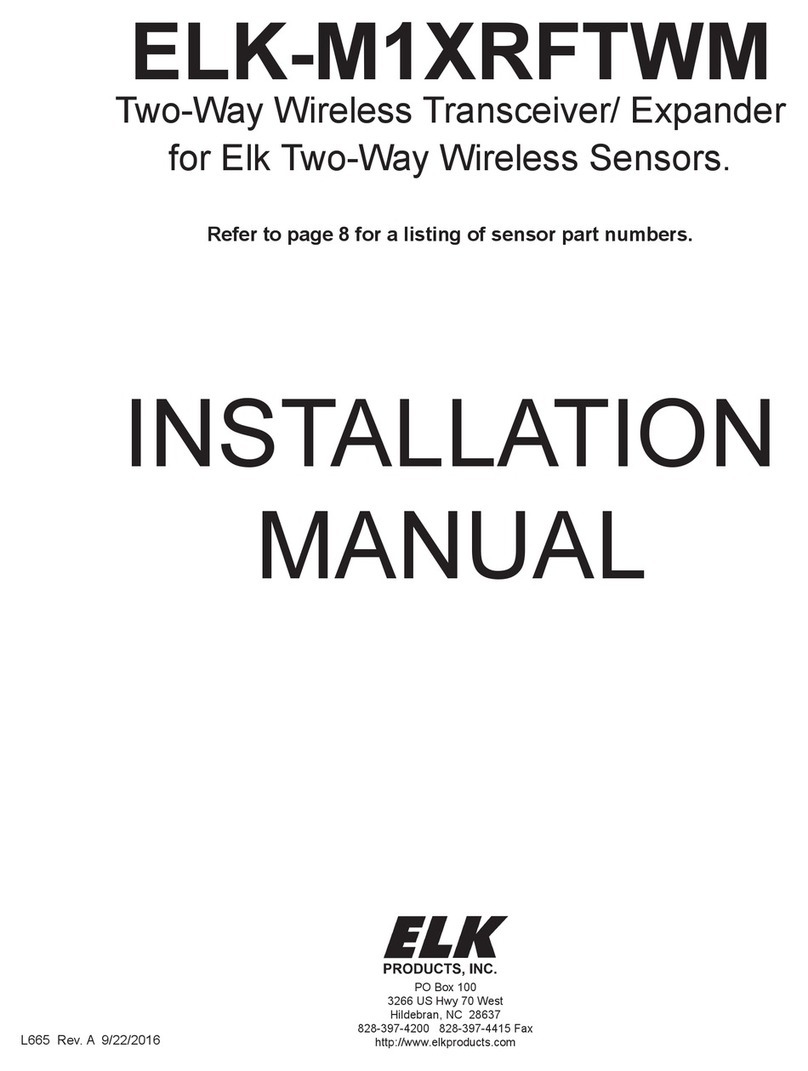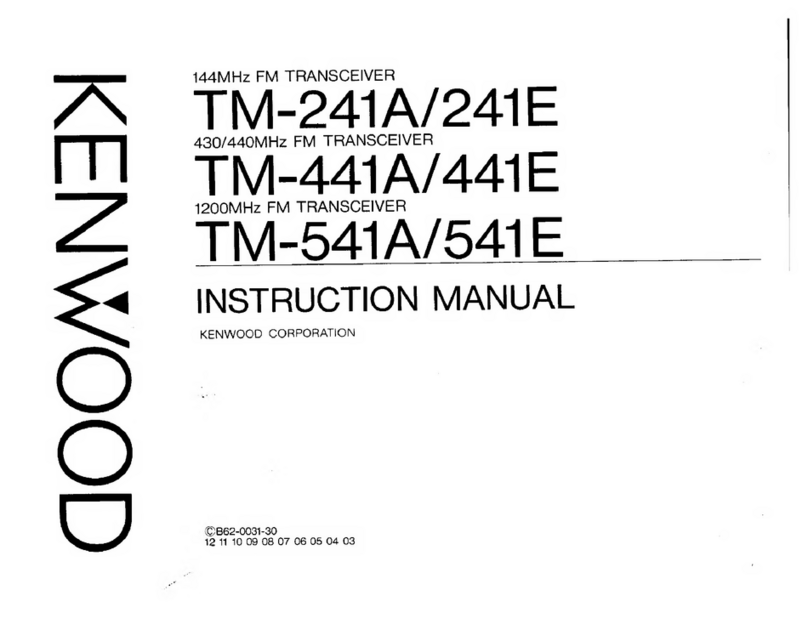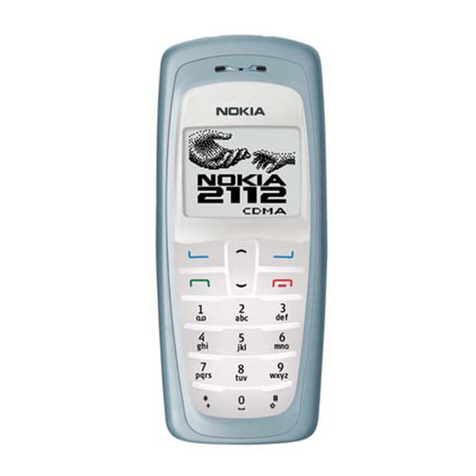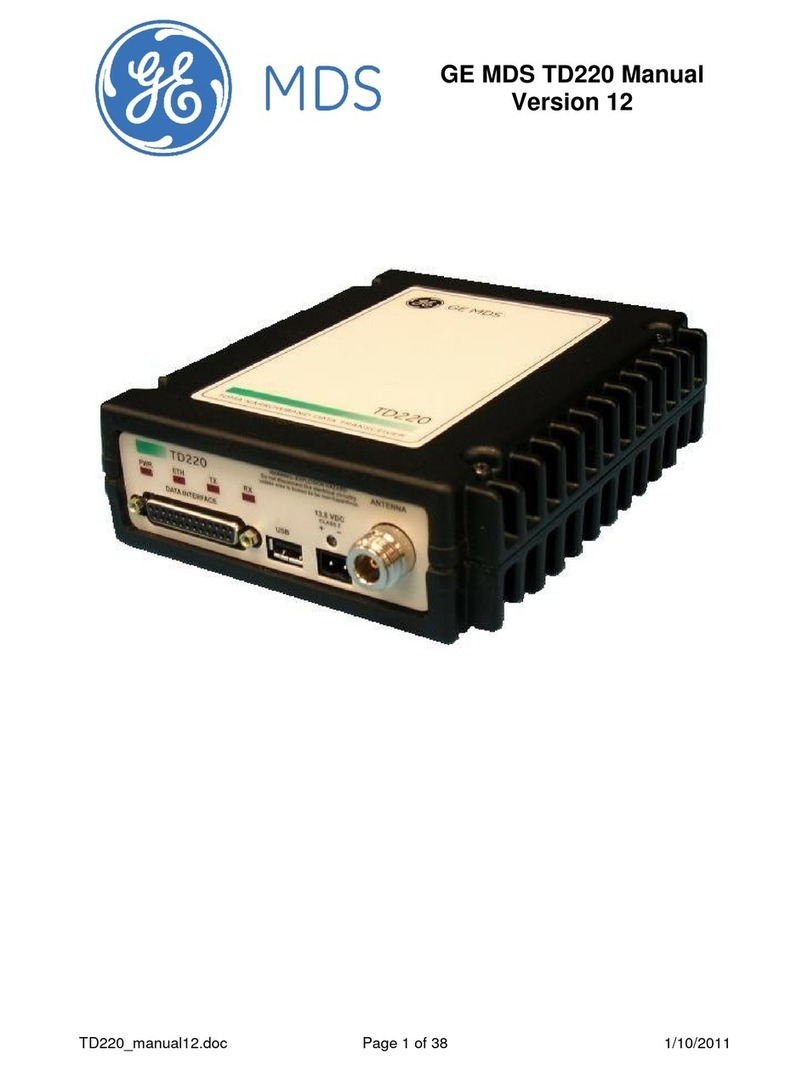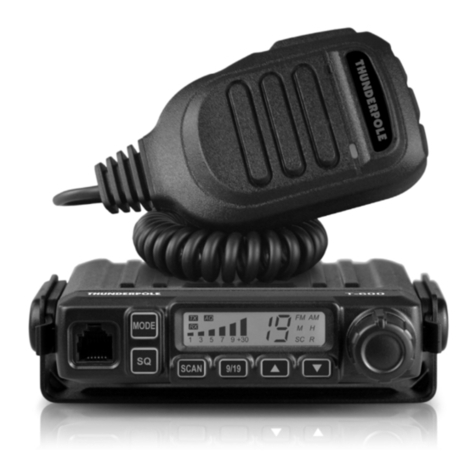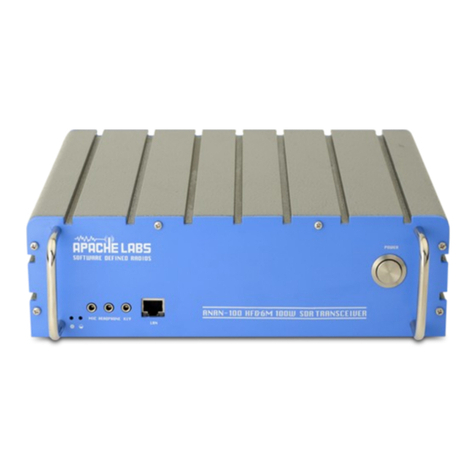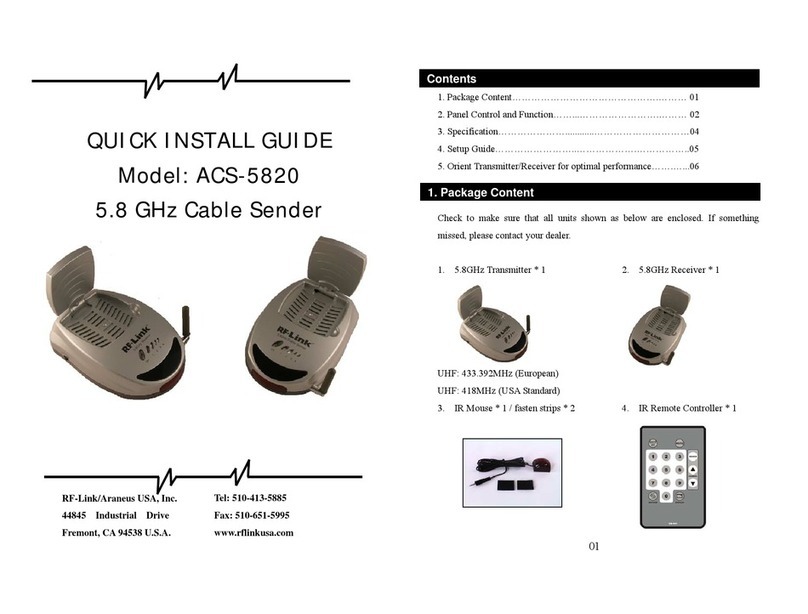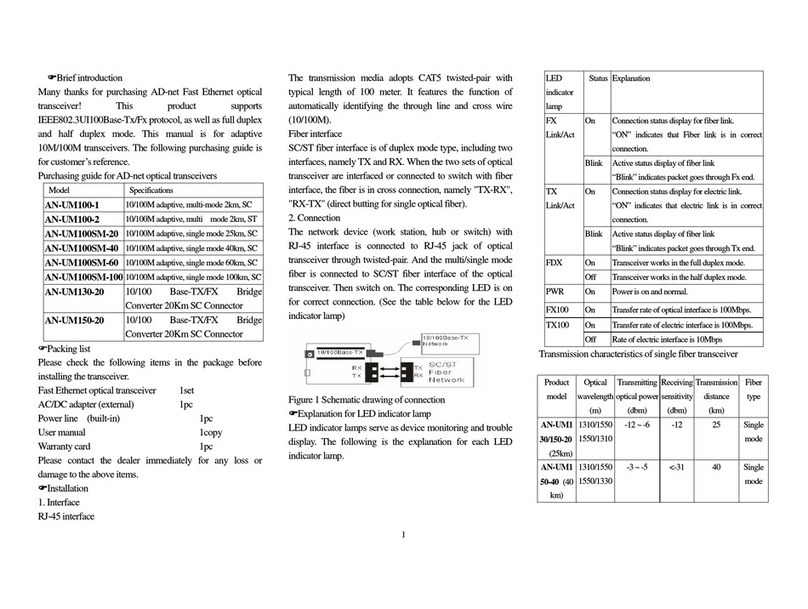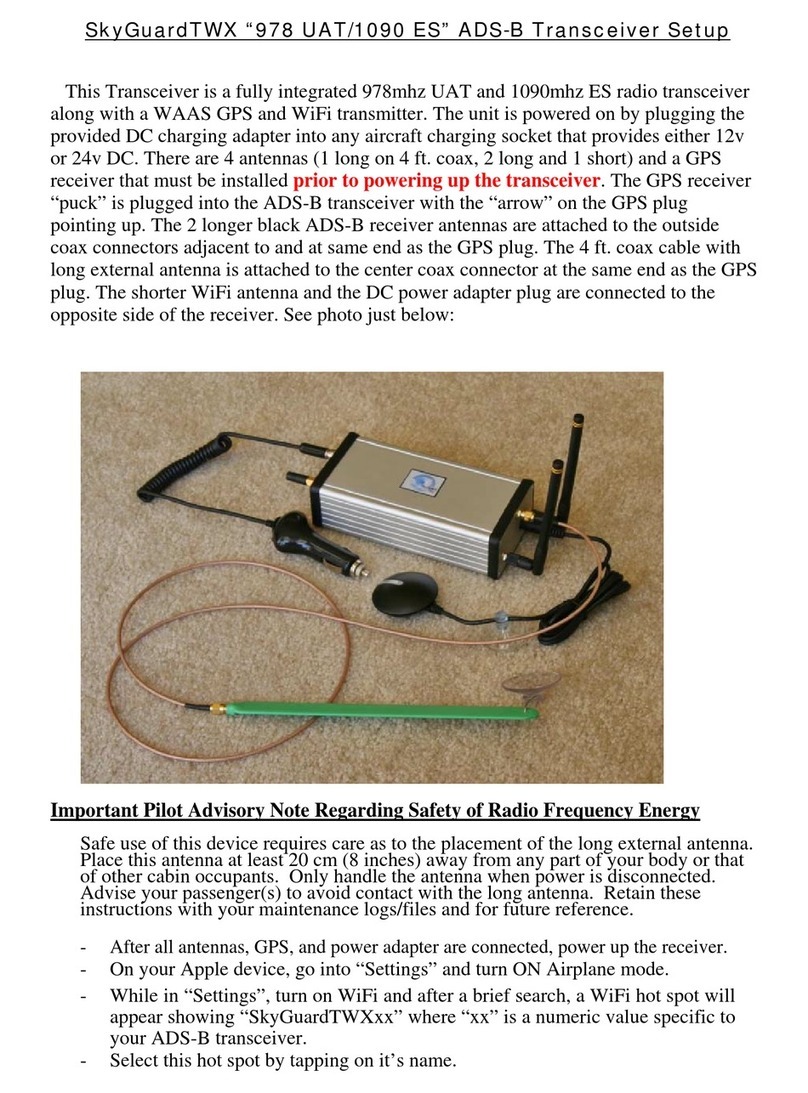Icom IC-F9511S User manual

INSTRUCTION MANUAL
This device complies with Part 15 of the FCC
Rules. Operation is subject to the condition that
this device does not cause harmful interference.
VHF P25 TRUNKING
MOBILE TRANSCEIVERS
iF9511S
iF9511T
The photo shows the 10-key version transceiver.
UHF P25 TRUNKING
MOBILE TRANSCEIVERS
iF9521S/T
iF9523S/T

i
IMPORTANT
READ ALL INSTRUCTIONS carefully and com-
pletely before using the transceiver.
SAVE THIS INSTRUCTION MANUAL — This
instruction manual contains important operating instruc-
tions for the IC-F9511S/IC-F9511T VHF P25 TRUNKING
MOBILE TRANSCEIVERS and the IC-F9521S/IC-F9521T/
IC-F9523S/IC-F9523T UHF P25 TRUNKING MOBILE
TRANSCEIVERS.
✔When the optional UT-125 aes/des encryption
u n i t is installed:
If re-exporting this product and/or AES encryption of this
product is activated, you must comply with the export regula-
tions of your country, which can be highly restrictive. YOUR
FAILURE TO COMPLY WITH EXPORT REGULATIONS MAY
SUBJECT YOU TO FINES OR PENALTIES. AES encryption
products including this software fall under the control of the
Japanese Government as described in Appendix I: Export Le-
gal Controls and Appendix: Exchange Legal Controls. Please
consult with your dealer or sales representative for details.
EXPLICIT DEFINITIONS
WORD DEFINITION
RWARNING! Personal injury, fire hazard or electric
shock may occur.
CAUTION Equipment damage may occur.
NOTE
If disregarded, inconvenience only. No risk
of personal injury, fire or electric shock.
See the operating guide for details of Analog, MDC and
P25 Trunking/Conventional system operations. Consult
your Icom dealer or system operator for details concern-
ing your transceivers programming.
✔ INFORMATION:
In this instruction manual, the following descriptions are used;
IC-F9511S/IC-F9521S/IC-F9523S : “Simple type”
IC-F9511T/IC-F9521T/IC-F9523T : “10-key type”
Icom, Icom Inc. and the Icom logo are registered trademarks of Icom Incor-
porated (Japan) in Japan, the United States, the United Kingdom, Germany,
France, Spain, Russia and/or other countries.
All other products or brands are registered trademarks or trademarks of their
respective holders.

ii
FCC INFORMATION
• FOR CLASS B UNINTENTIONAL RADIATORS:
This equipment has been tested and found to comply with
the limits for a Class B digital device, pursuant to part 15 of
the FCC Rules. These limits are designed to provide reason-
able protection against harmful interference in a residential
installation. This equipment generates, uses and can radiate
radio frequency energy and, if not installed and used in ac-
cordance with the instructions, may cause harmful interfer-
ence to radio communications. However, there is no guaran-
tee that interference will not occur in a particular installation.
If this equipment does cause harmful interference to radio or
television reception, which can be determined by turning the
equipment off and on, the user is encouraged to try to cor-
rect the interference by one or more of the following meas-
ures:
•Reorientorrelocatethereceivingantenna.
•Increasetheseparationbetweentheequipmentandre-
ceiver.
•Connecttheequipmentintoanoutletonacircuitdiffer-
ent from that to which the receiver is connected.
•Consultthedealeroranexperiencedradio/TVtechni-
cian for help.
CAUTION: Changes or modifications to this transceiver,
not expressly approved by Icom Inc., could void your author-
ity to operate this transceiver under FCC regulations.
ABOUT IPR
This device is made under license under one or more of the
following U.S. Patents: #4,590,473; #4,636,791; #5,148,482;
#5,185,796; #5,271,017; #5,377,229; #4,716,407;
#4,972,460; #5,502,767; #5,146,497; #5,164,986;
#5,185,795; #5,164,986, #5,185,795, and #5,146,497.
* IPR means ‘Intellectual Property Rights.’
VOICE CODING TECHNOLOGY
The AMBE+2™ voice coding Technology embodied in this
product is protected by intellectual property rights including
patent rights, copyrights and trade secrets of Digital Voice
Systems, Inc. This voice coding Technology is licensed sole-
ly for use within this Communications Equipment. The user
of this Technology is explicitly prohibited from attempting to
extract, remove, decompile, reverse engineer, or disassem-
ble the Object Code, or in any other way convert the Object
Code into a human-readable form. U.S. Patent Nos.
#5,870,405, #5,826,222, #5,754,974, #5,701,390,
#5,715,365, #5,649,050, #5,630,011, #5,581,656,
#5,517,511, #5,491,772, #5,247,579, #5,226,084 and
#5,195,166.

iii
RWARNING! NEVER connect the transceiver to an AC out-
let. This may pose a fire hazard or result in an electric shock.
RWARNING! NEVER connect the transceiver to a power
source of more than 16 V DC such as a 24 V DC. This could
cause a fire or damage the transceiver.
RWARNING! NEVER reverse the DC power cable polar-
ity when connecting to a power source. This could damage
the transceiver.
RWARNING! NEVER cut the DC power cable between
the DC plug and fuse holder. If an incorrect connection is
made after cutting, the transceiver might be damaged.
CAUTION: NEVER place the transceiver where normal
operation of the vehicle may be hindered or where it could
cause bodily injury.
CAUTION: NEVER expose the transceiver to rain, snow
or any liquids. The transceiver may be damaged.
DO NOT use or place the transceiver in areas with tem-
peratures below –30°C (–22°F) or above +60°C (+140°F), or
in areas subject to direct sunlight, such as the dashboard.
DO NOT place the transceiver in excessively dusty environ-
ments or in direct sunlight.
DO NOT place the transceiver against walls or putting any-
thing on top of the transceiver. This will obstruct heat dissi-
pation.
DO NOT use harsh solvents such as benzine or alcohol to
clean the transceiver, as they will damage the transceiver’s
surfaces. If the transceiver becomes dusty or dirty, wipe it
clean with a soft, dry cloth.
During mobile operation, DO NOT operate the transceiver
without running the vehicle’s engine. When the transceiver’s
power is ON and your vehicle’s engine is OFF, the vehicle’s
battery will soon become exhausted.
BE CAREFUL! The transceiver will become hot when op-
erating continuously for long periods of time.
Place the transceiver in a secure place to avoid inadvertent
use by children.
When the optional RMK-2 and the supplied/optional micro-
phone* are attached, the transceiver’s front panel meets
IP54 requirements for dust-protection and splash resistance.
However, once the front panel with the RMK-2 have been
dropped, dust-protection and splash resistance cannot be
guaranteed because of possible damage to these cases or
the waterproof seal.
* The main body of the microphone is not dust-protection and splash
resistance.
Use Icom microphones only (supplied or optional). Other
manufacturer’s microphones have different pin assignments,
and may damage the transceiver.
PRECAUTIONS

iv
TABLE OF CONTENTS 1
2
3
4
5
6
7
8
9
10
11
12
13
14
15
16
IMPORTANT.......................................................................... i
EXPLICIT DEFINITIONS....................................................... i
FCC INFORMATION ............................................................ ii
ABOUT IPR .......................................................................... ii
VOICE CODING TECHNOLOGY ......................................... ii
PRECAUTIONS................................................................... iii
TABLE OF CONTENTS....................................................... iv
1 PANEL DESCRIPTION................................................1–6
n Front panel ...................................................................1
n Function display ...........................................................3
n Programmable function keys........................................4
2 BASIC OPERATION..................................................7–12
n Turning power ON ........................................................7
n Channel selection.........................................................7
n Receiving and transmitting...........................................8
n Clock function...............................................................9
n Wake up function........................................................10
n Sleep function ............................................................11
n User set mode............................................................12
3 CONNECTION AND MAINTENANCE ....................13–15
n Rear panel connection ...............................................13
n Supplied Accessories.................................................14
n Mounting the transceiver ............................................15
n Antenna......................................................................15
n Fuse replacement ......................................................15
n Cleaning .....................................................................15
4 OPTIONS.......................................................................16
5 SAFETY TRAINING INFORMATION.......................17–18

1
1PANEL DESCRIPTION
01 ch- 0 1
IC-F9511T
o
qe*w
e*
Simple type
10-key type
yruti
nFront panel
qAF VOLUME CONTROL KNOB
Rotate the knob to adjust the audio output level.
•Minimumaudiolevelispre-programmed.
wFUNCTION DISPLAY (p. 3)
Displays a variety of information, such as an operating
channel number/name, DTMF numbers and audible con-
dition, etc.
eDIAL or UP/DOWN KEYS
•Simpletype:DIAL
Rotate to select an operating channel, etc.
•10-keytype:UP/DOWN Keys
Push to select an operating channel, etc.
*The desired function can be assigned by your dealer. (p. 4)

2
1
PANEL DESCRIPTION
1
2
3
4
5
6
7
8
9
10
11
12
13
14
15
16
r10-KEYPAD (10-key type only)
The keypad allows you to enter digits to:
•Selectmemorychannels,tonechannelsandDTMFcodes
(when in the DTMF code channel selection mode)
•Startupwithapassword
•InputtheIndividualIDcodefordigitaloperation.(Dependingon
the pre-setting)
tBUSY INDICATOR
Lights green while receiving a signal, or when the squelch
is open.
yPOWER SWITCH [POWER]
Push to turn the power ON and OFF.
•ThefollowingfunctionsareavailableatpowerONasoptions:
- Automatic scan start
- Password prompt
- Set mode
uTRANSMIT INDICATOR
Lights red while transmitting.
iDEALER-PROGRAMMABLE KEYS
Desired functions can be programmed independently by
your dealer. (p. 4)
In this instruction manual, these keys are from the left,
called [P0]/[P1]/[P2]/[P3]/[P4].
oMICROPHONE CONNECTOR
Connect the supplied or optional microphone.
•Whenyouconnectamicrophone,besuretofittheconnector
cover of the microphone into the connector to maintain the front
panel’s dust protection and splash resistance*.
*Only when the optional RMK-2 is attached.
Connector cover
RMK-2
NEVER connect non-specified microphones. The pin
assignments may be different and the transceiver may
be damaged.
DMICROPHONE
The supplied microphone has a PTT switch and a hanger
hook.
•Thefollowingfunctionsareavailablewhenthemicrophoneis
on or off hook (depending on the setting):
- Automatic scan starts when it is on hook.
- Scan is cancelled when it is off hook.
- Scan is paused when it is off hook.
-
Automatic priority channel selection is available when it is off hook.
- Sets to ‘Inaudible’ condition (mute condition) when it is on hook.
-
Sets to ‘Audible’ condition (unmute condition) when it is off hook.

3
1PANEL DESCRIPTION
nFunction display
01 ch-0 1
Ic-F9511T
uqw erty i
!0
o
q RECEIVED SIGNAL STRENGTH INDICATOR
Indicates relative signal strength level.
Weak Receive Signal levelStrong
wLOW POWER INDICATOR
Appears when low output power is selected.
•Whenhighoutputpowerisselected,noindicatorappears.
eAUDIBLE INDICATOR
Appears when the channel is in the ‘audible’ (unmute)
condition.
rCOMPANDER INDICATOR
Appears when the compander function*is activated.
* Analog mode operation only
tSCRAMBLER INDICATOR
Appears when the voice scrambler or encryption function
is activated.
yBELL INDICATOR
Appears/blinks when a matched signal is received, de-
pending on the pre-programming.
uTELEPHONE INDICATOR
Appears when a phone call* is received.
* P25 operation only
iSHORT MESSAGE INDICATOR
Appears when an Status message or Short message is
received.
oALPHANUMERIC DISPLAY
Displays an operating channel number, channel name,
Set mode contents, DTMF code, etc.
!0 ACTIVATED KEY INDICATOR
Appears above the key assigned as [Scan Add/Del (Tag)]
key when that key has been activated.
See the operating guide for details of Analog, MDC and
P25 Trunking/Conventional system operations. Consult
your Icom dealer or system operator for details concern-
ing your transceiver’s programming.

4
1
PANEL DESCRIPTION
1
2
3
4
5
6
7
8
9
10
11
12
13
14
15
16
nProgrammable function keys
The following functions can be assigned to [DIAL]*, [UP],
[DOWN], [P0], [P1], [P2], [P3] and [P4] programmable func-
tion keys.
Consult your Icom dealer or system operator for details con-
cerning your transceivers programming.
If the programmable function names are bracketed in the fol-
lowing explanations, the specific key is used to activate the
function depends on the programming.
*The functions you can assign to [DIAL] are limited.
(Only functions marked with ✩can be assigned.)
✩CH UP AND DOWN KEYS
➥Push (or Rotate)* to select an operating channel.
➥Push (or Rotate)* to select a scan group after pushing
and holding [Scan].
*Rotate when this function is assigned to [DIAL].
✩
ZONE UP AND DOWN KEY (This function is for [DIAL] only)
Rotate to select the desired zone.
ZONE KEY
Push this key, then push [CH Up] or [CH Down] or rotate [CH
Up/Down]* to select the desired zone.
What is “zone”?—The desired channels are assigned
into a zone according to the intended use for grouping.
For example, ‘Staff A’ and ‘Staff B’ are assigned into a
“Business” zone, and ‘John’ and ‘Cindy’ are assigned into
a “Private” zone.
SCAN KEY
➥Push to start and cancel scanning operation.
•WhenthePowerONScanorAutoScanfunctionstartsascan,
push this key to cancel the scan. The canceled scan resumes
after a specified time period.
➥ P ush and hold this key for 1 sec. to indicate a scan group,
then push [CH Up] or [CH Down] or rotate [CH Up/Down]*
to select the desired one. (Depending on the pre-setting.)
*Simple type only

5
1PANEL DESCRIPTION
SCAN ADD/DEL (TAG) KEY “SCAD”
Push to add a channel to, or delete it from the current scan➥
list.
When a channel is added to the current scan list, the display•
quickly shows “SCAN ON.” When a channel is deleted from the
current scan list, the display quickly shows “SCAN OFF.” After
showing “SCAN ON” or “SCAN OFF,” the display quickly shows
the current scan list text.
You can add a channel to, or delete it from the scan list➥
after selecting the list.
1.
Hold down for 1 second to display the current scan list, and
then push [CH Up] or [CH Down] to select a desired list.
2. Push this key to add a channel to, or delete it from the
selected list.
•
When a channel is added to the selected scan list, the display
quickly shows “SCAN ON.” When a channel is deleted from
the selected scan list, the display quickly shows “SCAN OFF.”
3. Hold down this key for 1 second to exit the scan list
selection mode.
Push this key while a scan is paused on a channel, except➥
for primary or secondary channel, and then the channel is
deleted from the scan list.
Depending on the setting, the deleted channel is added to the•
scan list again after the scan is cancelled. (Nuisance Delete
function)
PRIO A/B KEYS
➥Push to select Priority A or Priority B channel.
➥Push and hold [Prio A (Rewrite)] or [Prio B (Rewrite)] for
1 sec. to assign the operating channel to the Priority A or
Priority B channel.
MR-CH 1/2/3/4 KEYS
Push to select the memory channel 1, 2, 3 or 4.
MONI KEY
➥Push to mute and release the CTCSS (DTCS), 2-tone,
NAC or Talkgroup ID squelch mute. Open any squelch/
deactivate any mute while pushing and holding this key.
•Dependingonthe pre-setting,the‘Audible’(unmute)condition
may automatically return to the ‘Inaudible’ (mute) condition, af-
ter a specified time period.
➥Depending on the pre-setting, pushing and holding this
key for 1 sec. cancels the scan.
TALK AROUND KEY (Conventional operation only)
Turn the talk around function ON or OFF.
•Thetalkaroundfunctionequalizesthetransmitfrequencytothe
receive frequency for transceiver-to-transceiver communication.
PUBLIC ADDRESS KEY
Push to activate the Public Address (PA) function. When the
PA function is activated, the audio output can be controlled
from the transceiver separately with [CH Up] or [CH Down]
or rotate [CH Up/Down]*.
•Thisfunctionisavailablewhentheexternalunit,suchasanaudio
amplifier, speaker, etc. is additionally connected. (p. 14)
•Pushthiskey,thenspeakintothemicrophonewhilepushingand
holding [PTT].
*Simple type only

6
1
PANEL DESCRIPTION
1
2
3
4
5
6
7
8
9
10
11
12
13
14
15
16
RX SPEAKER KEY
Push to turn the RX speaker function ON or OFF.
When the RX speaker function is turned ON, the received
audio can be heard via the external speaker that is connect-
ed to the D-Sub 25-pin.
•Thisfunctionisavailablewhentheexternalspeakerisadditionally
connected. (p. 14)
•Thisfunctionisusefulwhenyouareoutofthevehicle.
•Theaudiooutputlevelislinkedtothetransceiver’svolumecontrol.
LOCK KEY
Push and hold to electronically lock all programmable keys
except the following:
[Moni], [Light], [Lock], [Emergency], [Surveillance] and [OPT 1/2/3].
LIGHT KEY
Push to turn the transceiver’s backlight ON for about 5 sec.
when the backlight function is turned OFF in user set mode.
(p. 12)
HIGH/LOW KEY
Push to select the transmit output power temporarily or per-
manently, depending on the pre-setting.
•Askyourdealerfortheoutputpowerlevelforeachselection.
SURVEILLANCE KEY
Push to turn the surveillance function ON or OFF.
When this function is turned ON, the beep is not emitted and
the LCD backlight does not light when a signal is received or
a key is pushed, etc.
HOOK SCAN KEY
When the on hook scan function is activated, push this key
to stop scanning temporarily. Push this key again to re-start
scanning.
USER SET MODE KEY
➥Push and hold to enter user set mode.
•Duringintheusersetmode,pushthiskeytoselectanitemthat
is enabled by your dealer, and change the value or condition by
pushing [CH Up] or [CH Down] or rotating [CH Up/Down]*.
➥Push and hold this key again to exit user set mode.
OPT 1/2/3 KEYS
Push to control the output signal level from the optional unit
connector.
CLOCK KEY
➥Push to indicate the current time on the LCD. (p. 9)
•Whilethecurrenttimeisindicated,pushandholdthiskeyfor
1 sec. to enter the time data edit mode.
➥Push and hold for 1 sec. to enter the clock set mode.
(pp. 10, 11)
•Duringintheclocksetmode,pushthiskeytoselectanitem,
and change the value or condition by pushing [CH Up] or [CH
Down] or rotating [CH Up/Down]*.
*Simple type only

7
2BASIC OPERATION
nTurning power ON
When you use the transceiver for the first time, or after the
transceiver has sat unused for a long time, make sure to
check the date and time indication after turning the power
ON. If the time and date are not correct, reset them.
(p.10)
qPush [ ] to turn the power ON.
wIf the transceiver is programmed for a start up password,
input the digit codes as directed by your dealer.
•10-keypad*canbeusedforpasswordinput.
*10-key type only:
•Thekeysasbelowcanbeusedforpasswordinput:
The transceiver detects numbers in the same block as identical.
Therefore “01234” and “56789” are the same.
P0 P4P3P2P1
*In this instruction manual, these keys are
from the left, called [P0]/[P1]/[P2]/[P3]/[P4].
KEY P0 P1 P2 P3 P4
NUMBER 0
51
62
73
84
9
eWhen the “PASSWORD” indication does not clear after
inputting 6 digits, the input code number may be incorrect.
Turn the power OFF and start over in this case.
nChannel selection
Several types of channel selections are available. Methods
may differ according to your system set up.
NON-ZONE TYPE:
To select the desired operating channel:
•Push[CHUp]or[CHDown].
•Rotate[CHUp/Down]*.
•Pushoneof[MR-CH1]to[MR-CH4].
ZONE TYPE:
To select the desired zone:
•Push[Zone],thenpush[CHUp]or[CHDown].
•Rotate[ZoneUp/Down]*.
AUTOMATIC SCAN TYPE:
Channel setting is not necessary for this type. When turning
power ON, the transceiver automatically starts scanning.
Scanning stops when receiving a call.
*Simple type only

8
2
BASIC OPERATION
1
2
3
4
5
6
7
8
9
10
11
12
13
14
15
16
nReceiving and transmitting
Receiving:
qPush [ ] to turn the power ON.
wPush [CH Up] or [CH Down], or rotate [CH Up/Down]* to
select a channel, in sequence.
eWhile receiving a call, adjust the audio output level to a
comfortable listening level.
*Simple type only
Transmitting:
Wait for the channel to become clear to avoid interference.
qTake the microphone off hook.
•The‘audible’conditionisselectedandBUSYindicatorlights
green.
•Aprioritychannelmaybeselectedautomatically.
wWait for the channel to become clear.
•ThechannelisbusywhenBUSYindicatorlightsgreen.
eWhile pushing and holding [PTT], speak into the micro-
phone at your normal voice level.
rRelease [PTT] to receive.
IMPORTANT: To maximize the readability of your signal;
1. Pause briefly after pushing [PTT].
2. Hold the microphone 5 to 10 cm (2 to 4 inches) from
your mouth, then speak into the microphone at a nor-
mal voice level.
DTransmitting notes
• Transmit inhibit function
The transceiver has several inhibit functions which restrict
transmission under the following conditions:
-The channel is in mute condition (‘Inaudible’ condition;
“” does not appear.)
-The channel is busy.
-Un-matched (or matched) CTCSS is received.
(Depending on the pre-setting)
-Un-matched (or matched) NAC is received.*
(Depending on the pre-setting)
-The selected channel is a ‘receive only’ channel.
*Digital mode operation only.
• Time-out timer
After continuous transmission for the pre-programmed time
period, the time-out timer is activated, causing the trans-
ceiver to stop transmitting.
• Penalty timer
Once the time-out timer is activated, transmission is further
inhibited for a period determined by the penalty timer.

9
2BASIC OPERATION
nClock function
The transceiver indicates the current time and date when
[Clock] is pushed. And you can change the indication format
and time/date settings.
When you use the transceiver for the first time, or after
the transceiver has sat unused for a long time, make sure
to check the date and time indication after turning the
power ON. If the time and date are not correct, reset
them. (p.10)
DTime and date indication
qPush [Clock] to indicate the current time and date on the
LCD.
•Whentheindicationformatissetto12-hour,“AM”or“PM”is
indicated.
•TheLCDindicationreturnstothestand-bymodeafter30sec.
has passed with no operation.
12HR 12:00PM
YMD08-04-01
The time indication format (12-hour/24-hour) Time
Date
Date indication format (Y: Ye ar, M: Month, D: Day)
wPush [Clock] again to return to the stand-by mode.
DTime and date settings
qPush [Clock] to indicate the current time and date on the
LCD.
12HR 12:00PM
YMD08-04-01
wPush and hold [Clock] for 1 sec. to enter the time and date
setting mode.
•Thetimeindicationformat,“24HR”or“12HR”blinks.
12HR 12:00PM
YMD08-04-01
ePush [Clock] to select the desired item to be changed.
rPush [CH Up] or [CH Down], or rotate [CH Up/Down]* to
set the selected item.
*Simple type only
12HR 03:00PM
YMD08-04-01

10
2
BASIC OPERATION
1
2
3
4
5
6
7
8
9
10
11
12
13
14
15
16
tPush [Clock] to set.
•Thenextitemblinks.
12HR 03:00PM
YMD08-04-01
yRepeat steps eto tto set items.
uAfter setting, push and hold [Clock] for 1 sec. to program.
•Returntothetimeanddatesettingmode.
iPush [Clock] to return to the stand-by mode.
nWake up function
The wake up function allows the transceiver to be automati-
cally turned ON according to the wake up time setting.
qPush and hold [Clock] for 1 sec. to enter the clock set
mode.
•“WAKEUP”isindicated.
WAKE UP
OFF
wPush [CH Up] or [CH Down], or rotate [CH Up/Down]* to
turn the wake up function ON.
ePush [Clock] to set, and select “WAKE UP TIME.”
WAKE UP TIME
07:25AM
rPush [CH Up] or [CH Down], or rotate [CH Up/Down]* to
enter the wake up time edit mode.
•The‘hour’datablinks.
WAKE UP TIME
07:25AM

11
2BASIC OPERATION
tPush [CH Up] or [CH Down], or rotate [CH Up/Down]* to
input the ‘hour’ data for wake up time. After inputting, push
[Clock] to set.
•The‘minutes’datablinks.
WAKE UP TIME
09:25AM
yPush [CH Up] or [CH Down], or rotate [CH Up/Down]* to
Input the ‘minutes’ data for wake up time. After inputting,
push [Clock] to set.
WAKE UP TIME
09:30AM
uPush and hold [Clock] for 1 sec. to exit the clock set mode.
•Returntothestand-bymode.
*Simple type only
nSleep function
The sleep function allows the transceiver to be automatically
turned OFF according to the sleep time setting.
qPush and hold [Clock] for 1 sec. to enter the clock set
mode.
•“WAKEUP”isindicated.
wPush [Clock] several times to select “SLEEP.”
SLEEP
ON
ePush [CH Up] or [CH Down], or rotate [CH Up/Down]* to
select “ON” or “ON EXCPT EMR” to turn the sleep func-
tion ON.
•When“ONEXCPTEMER”isselected,thetransceiverwillbe
automatically turned OFF at the sleep time. However, during
the emergency mode, the sleep function will not function, even
if the sleep time period starts.
rPush [Clock] to set, and select “SLEEP TIME.”
SLEEPTIME
05:35PM

12
2
BASIC OPERATION
1
2
3
4
5
6
7
8
9
10
11
12
13
14
15
16
tPush [CH Up] or [CH Down], or rotate [CH Up/Down]* to
enter the sleep time edit mode.
•The‘hour’datablinks.
SLEEPTIME
05:35PM
yPush [CH Up] or [CH Down], or rotate [CH Up/Down]* to
Input the ‘hour’ data for sleep time. After inputting, push
[Clock] to set.
•The‘minutes’datablinks.
SLEEPTIME
08:35PM
uPush [CH Up] or [CH Down], or rotate [CH Up/Down]*
to Input the ‘minutes’ data for sleep time. After inputting,
push [Clock] to set.
SLEEPTIME
08:00PM
iPush and hold [Clock] for 1 sec. to exit the clock set mode.
•Returntothestand-bymode.
*Simple type only
nUser set mode
If the transceiver has [User Set Mode] assigned to it, you
can “customize” the transceiver operation to suit your prefer-
ences and operating style.
Entering the user set mode:
qPush and hold [User Set Mode] for 1 sec. to enter the User
Set mode.
wPush [User Set Mode] to select the appropriate item. Then,
push [CH Up] or [CH Down] to set the desired value or op-
tion.
•AvailablesetmodefunctionsareBacklight, LCD Contrast,
Beep, Beep Level, Ringer Level, SQL Level, AF Min. Level,
Mic Gain, Horn, Battery Voltage, Signal Moni, Lone Worker
and System Information.
ePush and hold [User Set Mode] for 1 sec. again to exit the
User Set mode.

13
3CONNECTION AND MAINTENANCE
r
Antenna
qew
qANTENNA CONNECTOR
Connects to an antenna.
Contact your dealer about
antenna selection and
placement.
wD-SUB 25-PIN
Connect an
external unit.
eEXTERNAL
SPEAKER JACK
Connect a 4–8 ø
external speaker.
rMICROPHONE HANGER
The supplied self ground
microphone can be used
for microphone on/off
hook functions. (See p. 2)
yDC POWER RECEPTACLE
Connects to a 12 V DC battery. Pay at-
tention to polarities.
Supplied speaker SP-35
(10-key types only. Simple types
have a built-in speaker.)
t
tIGNITION LEAD
Connects to an ignition line.
RDO NOT put a pressure to this lead.
Binding to the DC power cable is
recommended.
Black
Red
12V
Battery
y
Solder
Crimp
NOTE: Use the terminals
as shown below for the
cable connections.
Purchase separately
Connect the supplied micro-
phone hanger to the vehicle’s
ground for microphone on/off
hook functions when the op-
tional microphone (HM-152/T)
is used.
When the optional micro-
phone (HM-152/T) is used:
RWARNING! NEVER re-
move the fuse-holder from the
DC power cable.
RWARNING! NEVER connect to a
24 V battery. This could damage the
transceiver.
nRear panel connection

14
3
CONNECTION AND MAINTENANCE
1
2
3
4
5
6
7
8
9
10
11
12
13
14
15
16
nSupplied Accessories
KEY-STICKER
Microphone Microphone hanger
and screw set
DC power cable
Mounting bracket
Speaker*
1
Key caps Function name
stickers*
2
Flat washers
Spring washers
Bracket bolts
Mounting screws
(M5×12)
Self-tapping screws
(M5×16)
Nuts
*
2
10-key type only
Used for labelling the program-
mable function keys according
to their assinged functions.
*
1
• Function name stickers
There are no names on the programmable function keys
since the functions can be freely assigned to these keys.
Attach the supplied function name stickers as below to the
appropriate keys for easy recognition of that key’s assigned
function.
Then, protect the attached stickers from unsticking with the
supplied key cap as below.
Function name sticker
Key cap

15
3CONNECTION AND MAINTENANCE
nMounting the transceiver
The universal mounting bracket supplied with your trans-
ceiver allows overhead or dashboard mounting.
•Mountthetransceiversecurelywiththe4suppliedscrews
to a thick surface which can support more than 1.5 kg.
Felt*
Flat washer
Nut
Felt*
Spring washer
When using
self-tapping screws *Felts reduce the vibration effects.
nAntenna
A key element in the performance of any communication
system is an antenna. Contact your dealer about antennas
and the best places to mount them.
nFuse replacement
A fuse is installed in the supplied DC power cable. If a fuse
blows, or the transceiver stops functioning, track down the
source of the problem, have it repaired, and replace the
damaged fuse with a new rated one.
qFuse rating: 20 A
USE a 20 A fuse of the same type only.
nCleaning
If the transceiver becomes dusty or dirty, wipe it clean with a
soft, dry cloth.
DO NOT use harsh solvents such as benzene or
alcohol, as they damage the transceiver surfaces.
Other manuals for IC-F9511S
2
This manual suits for next models
5
Table of contents
Other Icom Transceiver manuals

